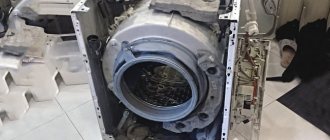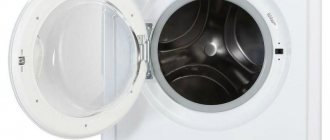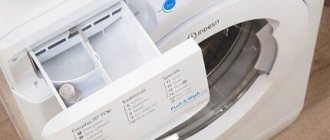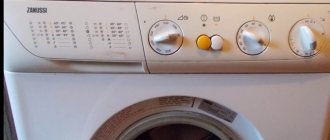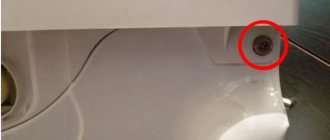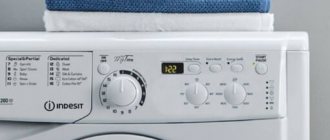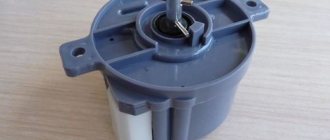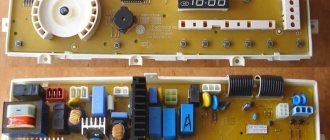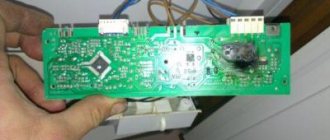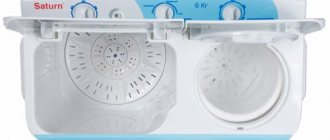With the advent of washing machines and other household appliances, performing household chores has become a simple task, which is why 90% of people have such units installed. Breakdowns can occur during operation even with products manufactured by well-known manufacturers. You can repair LG washing machines yourself; you just need to know the features of the process and some nuances that indicate changes in the performance of the device.
The Korean manufacturer uses modern technologies that make it possible to extend the life of parts or motors installed in washing machines - for this purpose, technology is used that uses the direct wire principle. Such washing machines are characterized by specific malfunctions that the average user needs to know in order to fix them at home.
Operating principles
The operation of modern washing machines is based on the general principles of similar devices that were used in the first stages of their production - water (ordinary, room temperature) enters the body, then it is heated by the device to user-specified values. Linen is placed inside the tank and washed using a rotating drum. This operating scheme is the main one for any device, so up to 70% of breakdowns are associated with the main components, the rest falls on the control panel and additional capabilities of the machine.
Features of work
In order to better understand the cause of the breakdown, you need to understand how the main stage of work is carried out after starting the program. The machine performs the following actions:
- The valve that supplies water to the tank opens (enters through a dispenser installed in the tank).
- The water is heated to the parameters specified by the program.
- The heating element turns on.
- The motor turns on, causing the drum to rotate.
- The main wash cycle is running.
- Finally, the water drain pump (pump) is turned on.
Also, to eliminate major breakdowns, you should know what the main elements of the device are called and what they do:
- Dispenser – container for detergents (powder, gels, softeners).
- Heating element – heating element.
- Tank – a container for water (it also contains a drum and heating element).
- Pressure switch (pressostat) – controls the level of filling of the tank with water, shuts off its supply if necessary.
Washing machine pressure switch
- Thermostat – controls the temperature indicators of water heating, connected to a pressure switch.
- Pump – a pump designed to drain water.
In addition to the details, you will need to take into account the presence of basic components in machines of this brand that ensure stable and uninterrupted operation of the device. The devices contain:
- Water filling system.
- Water heating system.
- A system that starts and carries out laundry washing.
- Water drainage unit.
- System for spinning washed clothes.
- Drying system for washed clothes
It is important to remember and take into account when carrying out repairs with your own hands that in each subsequent model the company’s developers strive to improve a certain system or component, add parts to it and increase the range of functions performed. This can complicate the process and make it impossible to do at home, so it is recommended that you carefully read the operating instructions supplied with the washing machine to avoid premature repair work.
You will have to be careful and follow the rules already at the stage of loading laundry, since, for example, a button that comes off during washing can damage the drum or the system responsible for draining the water.
Common types of breakdowns
Washing machines of this brand meet all international requirements, standards, and regulations, but even with them, breakdowns can occur. The main source of pride for LG washing machines is the engine. According to statistics, out of 500 calls to a workshop or service center, only 1 case is associated with the breakdown of this part. In 90% of cases, failure is associated with faults caused by manufacturing defects. In 70% of cases, breakdowns occur in moving elements and parts that are subject to increased load.
The main units of the LG washing machine that become unusable and must be replaced in most cases:
- A heating element.
- Pressure switch.
- Various wires and terminals.
- Drain pump.
- Fill valve.
It is important to remember that these elements are basic, without them the operation of the unit is not possible.
Symptoms of breakdowns manifest themselves differently for each machine. To carry out independent diagnostic measures, it is necessary to analyze the cases that occurred with other devices from this company. Only after a person is sure of the cause of the breakdown can the unit be disassembled.
Approximate breakdowns
If we analyze recorded cases of failure of the heating element (heating element), then the error code that will appear on the display will be “NOT”. In some cases, no indication appears, but the problem is present. Then, before carrying out repair work with your own hands, you will need to carefully monitor the washing process. Attention should be drawn to:
- The process of dissolving the powder (whether it dissolves completely, how long it takes).
- How warm or cold the manhole cover is during operation of the unit.
- Washing quality (whether the laundry is washed well or poorly after completing a full cycle).
If there are deviations from the stated standards, you should not undertake repairs - you will need to measure the voltage at the contacts of the heating element using a multimeter.
The pressure switch may also fail. The main symptom indicating a problem is the independent draining of water, which can occur at any stage of the washing cycle. You can determine the problem by observing how water constantly fills and then flows out of the tank. The problem is that the sensor installed in the unit does not send a signal that the tank is full to the required values, so the fill valve remains open. In 95% of cases, this type of breakdown can be fixed with your own hands.
Failure associated with failed bearings manifests itself in a loud squeaking sound when the drum rotates. Feature - the sound intensifies at high speeds. In order to properly carry out self-diagnosis, you will need to turn the washing machine drum left and right. If the bearings need to be replaced, a constant creaking or knocking noise will be heard during this procedure.
If problems such as:
- Closures
- Shutdown.
- Reboot the module.
In this case, you need to pay special attention to the condition of the wiring and terminals of the unit. Modules rarely need to be replaced. In 90% of cases, the main problem arises with the wires that fit the unit sensors, as they often fray, resulting in short circuits or burns.
Problems with drain pumps rarely occur. Durability is determined by the specific design of this element. A breakdown can occur due to a failure of the drainage path - it becomes clogged and the pump cannot fully function. This breakdown manifests itself in the inability to drain water automatically. In this case, the error code “OE” appears on the display.
Washing machine drain pump
Breakage can also occur with a part such as the filler valve cuff. Problems with this element manifest themselves in the constant supply of water to the washing machine tank. This happens even when it is turned off. The main way to check for a malfunction with this part is to listen; if there is a gurgle of water and the machine is turned off, then with a 95% probability it is the fill valve that is damaged.
It must be remembered that when performing diagnostics yourself, you should not just disassemble the elements, but also carry out a visual inspection, taking into account the relationship between the parameters specified on the display and those obtained after the completion of the washing cycle. You need to look at the quality of washing, spinning and rinsing, as well as draining water, since all these parameters are a single whole for the high-quality and complete operation of the washing machine.
Failures can also occur in such units and parts as:
- Electric door lock.
- Temperature sensor.
- Electric motor.
- RPM sensor.
- Seals.
If the machine has drying and steaming functions, then the following possible breakdowns are added:
- Steam generator failure.
- Air heater failure.
- Fan malfunction.
- Worn air temperature sensor.
When making the first diagnosis, you need to pay attention to the quality of drying the laundry.
Recommendations for repairing LG WD washing machines
_____________________________________________________________________________________
- Tips for choosing
- Malfunctions and their elimination
- Repair recommendations
- Exploitation
- Error codes
- Characteristics of LG SMA models
LG WD-80192s washing machine in operation. When the rotation starts in the washing mode, the drum moves with a sharp jerk, then rotates as usual. It does not display any errors. It jerks so hard that the belt whistles. The belt has stretched; if it becomes very uncomfortable, replace it with a new one. Tell me the parameters of the drive belt for LG 80130n. Belt marking 1173 J5. Wd-80130n, the lights on the menu panel are on! The problem is that there is no water flowing into the machine! I cleaned the filter and even went there without it! Water pressure 4-5! I've been using it for about 10 years. What could be the problem and how serious is it? How to eliminate it on your own? Check the UBL, if it is working, then open the module. LG WD-80192s washing machine malfunction. When you turn on the SMA, water is constantly being collected and drained, when you start any washing program for 6 minutes, then the IE error appears. I tried to clean the EK filter, but it didn’t help. Then, after reading the thread, I unscrewed the “EC” and blew it out from the reverse side. I unscrewed the water sensor and blew out the water sensor hose. The washing machine started working, but when the main mode ends, it again displays the IE error. Example, “Fast 30” mode stops in 13 minutes; “Synthetic” mode stops in 20 minutes. But then everything returned to its original state: dialing and draining 6 - 10 minutes and an IE error. I think that the water sensor is to blame, I ordered it, I’m waiting to see how the results come, I’ll post. Are there other possible reasons for the breakdown? If the pump is draining, then you need to get into the module. LG WD-80192s. I discovered a water leak in the area of the powder filling tray. It mostly leaks when the washer fills with water. Tell me what to do? Clean the pipe located under the hopper. Remove the top cover, take out the powder container and you will see everything. Malfunction of the CMA WD 10200ND washing machine. When turned on, the program is installed, but the “key” indicator does not light up, nothing starts. I tried to enable the service test, but nothing happened. I checked the hatch lock: there is voltage at terminal 3 (red wire), but there is nothing at terminal 1 (yellow with a red stripe). I applied zero to this terminal. The lock has been activated; the indicator (key) is on. The wire rang from the block to the lock, there was no break. There is no visible damage to the module. The module was “opened” (using a regular breadboard knife). I did not find any visible damage (in the form of darkening from overheating or poor soldering). I checked the heating element relay, it works, the power contacts close, there is a circuit. And it also turns out that the voltage in the network does not exceed 192 volts. Where else should I look? There was a similar case. The reason was in the heating element control relay. I took a regular 12V power supply, wound the ends of the wires around needles and, piercing the jellied meat, applied voltage to the coil of the heating element control relay. The relay worked, but the contacts did not close, I wanted to desolder the relay, but after several attempts to operate the relay, the contacts began to ring, and everything worked, it has been working for a year without problems. I think that due to the low voltage in the network, the relay contacts burned out, and after resuscitation the carbon deposits broke through. LG WD 10180 N. SMA normally runs any program from start to finish, but it doesn’t heat the water. It doesn’t show any errors, so we didn’t find out about it right away. The linen became somewhat gray after washing. An autopsy showed that the heating element is working, the resistance is about 30 Ohms. The sensor, which is located next to the heating element, shows a resistance of about 30 kOhm. The control unit is filled with silicone, I don’t know what to do next, tell me, who knows. The relay for turning on the heating element must be soldered (very often in LGI), this requires opening the module. Lji 80180 N. I select the mode, press start, the program starts (the lock is blocked) and starts turning on and off endlessly. Maybe someone has encountered this? Open the module, look for the burnt track. The LG WD 80192 N washing machine is faulty. The washing machine does not respond at all to pressing the Power button. I started checking from external sources, the hatch lock, the heating elements were 100% serviceable, I found terminals 4 and 5 stitched together on the electric motor block, (the oil seal was leaking) I realized that the reason should be looked for in the module. I will describe my actions: I opened the module, did it carefully, this is not the first time I have encountered this - with the LV, I did not find any visible damage. Connected it and measured the voltage. The voltage is supplied to the transformer, the output to the diode bridge is 15 volts, and then it’s not clear to me. And most importantly, the heatsink of the KIA7812A transistor (labeled IC7 on the module) is very hot. Replace the transistor. Fault in test mode LG 10192N. This is the problem - the machine turns on, I select a program, start, lock and silence. The time stands still, only the selected program blinks. In test mode, the symbols “8tO” and “U03” light up in turn. I'm testing the engine, everything is fine. After selecting test 4, “256” is displayed and everything freezes. Does anyone have any thoughts on this? There should probably be: start, blocking - start of water filling. 1st step - measurements of the heating element. Step 2 - look towards the valves. If there is no complete cartogram of the test in service mode, then there is nothing to do there. LG WD 80130N does not heat water. The heating element is new, I checked it and it works. I checked the temperature sensor - it works. The module was removed, there was no visual damage or burning smell. What else could it be? I set it to 30,60,95 degrees. How and where to check the voltage on the module. There is no power to the heating element. It was the same situation. I got the payment. A burning smell immediately appeared. It turned out that two tracks on the power chip and the heating element chip burned out. The LG WD 10180 N washing machine is in operation. It does not heat the water. I took out the heating element - it seemed normal, but there really was nothing to ring - I checked the 12V voltage with a tester for a break in the spiral and for a short circuit to the body - it was normal. I don’t know how to check the temperature sensor. If you check with a tester, what resistance should there be on the heating element? I looked at the board - in one place under the fill there was a black spot - perhaps the problem is the same - the solder burnt out or something like that. And another question - is it possible to check the heating element while the machine is operating by connecting a tester? Or check the heating element by connecting it to an outlet for a short time to see if it will heat up. We measure the resistance of the heating element, it should be around 30 Ohms. We measure the resistance of the heating element leg - body. Should be more than 500 kOhm. If everything is as described above, the heating element is normal (it is better to measure the breakdown on the housing when the tank is filled with water). Switch the tester to voltage. We connect the tester terminals to the contacts of the heating element. Turn on the washing machine and wait for voltage to appear. The heating element can be connected separately by briefly applying 220 V to it; you don’t have to put it in the water if it turns on for 2-3 seconds. The machine is WD-10160 N. The problem is that in any program it fills with water and you have to start turning it, but the engine just hums. The relays turn on in both directions, but the engine just hums. Sometimes he takes off like crazy. Everything else works. The engine is running, I checked it on another unit. It wouldn't hurt to look at the brushes though. Just in case, take measurements of the heating element, especially on the body. And it’s better at a moment when he’s wet. If all of the above has been checked, everything is fine and does not help, then you can already think about checking the triac. Lji WD 80192N. During the washing process everything went out. I checked, the thermistor in the transformer flew out, threw a jumper, the radiator and transformer were also hot. Tell me what needs to be checked next. It is necessary to disconnect the load from the secondary winding, try to turn it on - the transformer should not heat up if it is working properly. If it gets hot, there is an interturn short circuit - replace it. You also need to check 7805. And the diodes that shunt the relay windings. LG WD 10200ND problem with rotation. There is a problem with drum rotation. After turning on and drawing water, the machine tries to start the drum, but to no avail, the drum turns at some point, but with some noise in the motor (direct drive) when it stops, a strange thin sound appears. I checked the bearing, the drum rotates freely by hand, and in the 30 degree mode the heating element starts to heat up. There is one detail - it's called a Hall sensor. Open it or change it. LV 10192 N indicators do not light up and does not turn on. When the washing machine was operating in the washing mode, the drum was full of water, and suddenly all the indications went out, the SMA stood up and did not turn on. I disassembled it right down to the control unit, even removed the compound from the board to check if the tracks were burnt out. But I didn’t find anything there either. I ran the tester through everything, the power goes to the board, but in the board it disappears somewhere, since the power button rings, but for some reason the display and the washing machine do not start. Therefore, I expect help from you, what to do next, what modules to check and what resistors to look at? You may need to check the voltage at the outlet. LG WD 10200ND washing machine malfunction. Manual washing mode does not work. When selecting a mode, I turn the mode dial, but the LED does not light up in the desired mode, but all the LEDs are on. What to do? The best thing to do is call a professional. Tell me, LG intellowasher WD-80160N washing machine. In manual mode, the motor spins half a turn for 1.5-2 minutes, that is, it spins half a turn and stops, then after 1.5-2 minutes it tries to turn again and immediately stops. In other modes everything works fine. It pumps water and squeezes everything out fine. where could be the reason. Yes, even in test mode everything works too. Help me find the reason. There are no problems. The device is working fine. I decided to change the belt to 10180 n. I heard that 1173 G5 should be suitable. The question arose because this particular strap is in stock, there are suspicions that it is from her. But I haven’t been able to put it on yet - it’s too short. Or am I doing something wrong? I also couldn't find any tension adjustments. The belt is put on with tension and should ring. It won't tear. LG wd-10490n spin does not work. After rinsing, it hangs for 6 minutes before the end of the wash and does not spin. The pump is running. The same thing happens in spin mode. With and without downloading, the result is the same. In test mode, the speed is normal, there is no vibration. I checked the brushes. The belt is tight. I checked the Tacho sensor; when the engine is cranked by hand, the voltmeter needle deviates. No visible defects were found on the control board. All contact blocks have been checked. Where to look? The problem is most likely in the control module. There is an element in the feedback circuit from the motor triac that needs to be replaced. I have a Lji 10150 n machine, it washed normally, but for some time it stopped spinning - it jerks the drum a couple of times and it stops. The pump runs continuously during this time. The water fills and drains normally, the water heats up during washing, drains after washing, the brushes on the motor are normal, when switching to the service mode it wrings out, but not in normal mode. What could it be and how can it be cured? A possible reason is capacitor C131. It has lost its capacity and because of this the washing machine does not really spin. The WD-10130N turns on and off immediately, I removed one black contact from the UBL. Without the UBL it should turn on, check the buttons. Sharp rotation of the drum of the LG 80160N washing machine. The drum rotation does not correspond to the specified speed. Check the engine block for water ingress and burnout of the tachogenerator contacts on it; it is better to ring the engine from the connectors on the control board.
10130n 10150 n 10150nup 10154n 10160 n 10170nd 10180 n 10192n 10192s 10200nd 10480n 10490n 10490s 80130n 80150 80150n 80150nu 8015 4 n 80160 80160n 80160nu 80164n 80180 n 80192n 80192s 80250s 80480n 80490n
The spin cycle on the LG WD-10490N washing machine does not work. It seems like I found the reason, the capacitor c131 rang (100nK 275V X2 PCX2 335M MKP) does not work. Tell me what kind of more affordable capacitor can be replaced? Any non-polar 1 µF, voltage 275 volts or higher. LG WD-80250s washing machine malfunction. When turned on from any program, the drain pump immediately turns on. Doesn't show any errors. Replace the level sensor. If that doesn't help, then the module. The SMA does not turn on, there is no indication, the transformer is working! Tell me which way to look! LG WD-80160N. Open the module and check! Besides the transformer, there is a lot of things there. The LV 80250 washing machine is in operation. The washing mode switch barely works, the press is processed 1 time out of 20, and you have to press very hard, everything else works great, all the buttons are working, because of this you have to wash on the “cotton” mode or half an hour suffers with turning on the desired mode. Please suggest a solution to this problem. Replace buttons. Clean the plastic pusher guides. LG 10160 n (control buttons stick). The essence of the problem is that the machine does not respond to button presses the first time. Select the desired washing program and start the cycle, which is another quest. The washing machine has never been repaired. Haven't opened it yet. Tell me what to look for, what could it be? Maybe the contact pad on the buttons themselves is worn out? If they “stick”, it’s not the buttons themselves, but the pushers in the housing, which they press with your fingers. Sometimes they just get “dirty” in the grooves of the panel, and do not come off, preventing the button from opening. SMA LG WD-80250s. After turning it on, the drain pump works, I press the pause button, but it still drains the water. Next, I pick up a magic screwdriver, hit relay X111 (in the diagram) and the pump stops. I press the “start” button and the wash continues until it drains and everything repeats again. You need to open the module and check relays x111 and x112, which are located nearby, for sticking. LG 10200nd does not start. The machine turns on, the buttons do not work: start/pause, options, spin speed (the buttons click when pressed as expected), the numbers on the mode selection indicator do not light up clearly, and if anyone knows. Tell me what kind of bearing and what kind of oil seal is on it, otherwise it will soon run out. There was a similar case. One track on the board is damaged. And a couple of diodes flew out. In my opinion there is only one resistance, under the protective layer of the board. Oil seal 37x66x9.5/12, bearings 6205, 6206. While operating the LV 80250S machine, a problem arose: it stopped spinning in any washing mode. Those. At first, it carries out the program correctly, but as soon as it gets to the spin cycle, it either freezes or simply doesn’t spin. The drum rotates slightly back and forth, as when rinsing, but does not reach high spin speeds. After a couple of hours of such actions, the washing machine freezes and starts flashing all the dashboard lights at the same time (flashes-extinguishes-flashes-extinguishes). An empty machine spins properly, but a full one refuses to spin. What could be the problem? Electronics or mechanics? Apparently you have an ordinary imbalance. — Loaded, too little laundry; — Loaded laundry is distributed unevenly; — SMA is equipped with a drum balance control system. When washing heavy items, such as carpets or bathrobes, this system can stop the drum from rotating; — If the laundry is too wet at the end of the spin cycle, add small items to even out the load in the drum and repeat the spin process. Rearrange the laundry to ensure even rotation. LG WD-10192N does not spin after draining. During the washing program the machine is running, if the program includes the “Spin” mode. It hangs on the drain and continues to drain until I get tired of it. The “Spin” mode does not turn on. All displays work and do not show any errors. During washing and rinsing, the drum rotates in both directions. The brushes, however, spark, flashes of blue light are visible under the machine, and when the drum rotates clockwise (if viewed from the face), when starting the engine, sometimes uncharacteristic sounds are heard - not a grinding sound, but something like a loud click. Of course it’s time to change the brushes, the device is more than 10 years old. About 5-6 years ago, a whistling sound appeared when the drum was rotating, but then it went away. There are no blockages in the washing machine or hoses, water fills and drains without problems. Change brushes. Maybe the questions will disappear. The LG 80150N washing machine (load 3.5 kg) is installed and connected. Does not display an error when there is no water. For the first time I changed the bearings and seal in the SMA, everything went well, but after assembly the machine stopped giving an error when the water supply was turned off and started washing without it. If water is supplied, the wash cycle proceeds normally (water is drawn in and drained). The pressure switch was blowing, the relay clicks, I checked it with a tester - the resistance changes, the pipe is not damaged. Tell me what could be the problem? Look for a build error or figure out the algorithm. LG 80192N washing machine in operation. The problem is as follows: at the end of the wash, when the number 1 lights up on the timer, the machine runs for another 10 minutes, or even longer. Of course, it turns off eventually, but how can I fix it? Still, it’s somehow not normal. The numbers on the timer are approximate. If SMA is erasing, don't bother her. Lji WD-80150N. The machine stopped turning the drum. The engine was checked by a working one, the brushes are normal 4 cm long. The relay clicks on the power module, but there is some kind of ringing for 2 seconds after the relay clicks. What could it be? Most likely, don't get lost. The washing machine LV wd 10130n is in operation. The problem is this. We have been using it for 11 years, it worked without any complaints. The original heating element burned out, and at the same time it began to pierce the body, and the washer was electrocuted. Without thinking twice, I exchanged it for another one (not a new one, a friend had a similar one lying around). But this one didn’t live long either; I made a mistake on the control board relay. I took it apart, cut out the plastic in the right place and cleaned the silicone, there was nothing burnt anywhere, I decided to disassemble it and solder the contacts. I assembled it, installed a new heating element and armed myself with a multimeter. When I turned it on, no current was supplied to the heating element; when the tank was full, it turned on. I checked it periodically. When I heated the water and turned it off, I decided that everything was fine and left it alone, then I checked it on the spin cycle, and I realized that I could say goodbye to the brand new heating element. Tell me what could have happened. The heating element is new and does not penetrate the body. ULN is a key chip that receives signals from the processor and in turn controls power switches - triacs or relays. Check! Either the relay is stuck, or the transition to the ULN is flashing and the relay is closed for no reason. This is the second time I change the heating element in the LG 10192N washing machine. It heats up for six months and burns out. There is no scale. There is no breakdown to the body. There is no self-draining. Checking switching on, setting temperature, switching off - everything is normal. What could be the reason? As heating elements, network voltage, etc. and so on. Check the compression chamber up to the pressure switch. If there is a blockage, then the heating may be turned on erroneously when the tank is empty. LG WD-80160N (load 5 kg). I encountered such a problem as a very strange tank imbalance! In general, the fact is that the machine is certainly old, but everything in it is factory and original, nothing has been changed at all, except for the bearings! And the problem is that the tank of this model, for some reason, weighs heavily forward and because of this, during the spin cycle, the tank begins to shake very strongly, and it hammers its front counterweight very hard against the electric. module, and she all starts jumping and jumping. They checked the shock absorbers, they turned out to be extremely serviceable, despite its venerable age. But then they decided to put them on new ones, for an experiment, and still, the result was the same. The tilt of the tank forward remained the same, the shaking did not decrease at all. The suspension springs on which the tank hangs are also in excellent condition! It seems that either the front counterweight has become heavier than normal, or the rear upper counterweight has become lighter than expected, although they are both original, intact, undamaged and factory-made, and have never been changed on this washing machine. Yes, and then, because before everything was fine. And the counterweights could not change their weights during operation. The drum does not want to hang straight, but only hangs with a threatening tilt forward and gradually breaks the module with its blows. The bearings were changed recently, but I don’t think that the cause of the imbalance in the drum geometry could have been a banal replacement of the bearings. Moreover, before replacing the bearings, this imbalance was already present. During the process of replacing the bearings, the tank was probably removed, and perhaps the counterweights were also removed. And they put something on and put it together incorrectly. Maybe the same springs, maybe something else. The LG WD-80150N washing machine is installed and connected. The program crashed. The machine has a load of 6 kg, there is no 220V supply to the heating element after filling with water. And after drawing water during washing, I press pause, switch to the separate “drain and spin” function; there is no drain, but the water is drawn again. I do the same action after disconnecting the SMA from the power supply, I put it on spin, and it picks up water again, what could be the reason? The UBL works, the water level relay is the same as it should be (I changed it to a known working relay - the same thing). I removed the vacuum hose and checked it - it’s not clogged (everything is blowing). The heating element is working. I ran the test, everything works separately and the supply to the heating element and pump is 220V. The engine is normal, there is a spin and wash left and right. Help me what to do? The unit does not see a safe water level to turn on the heating element; the reason may be a clogged pressure sampling chamber. You will find it at the bottom, a pressure sensor tube goes to it. The washing machine 10160 N is in operation. The drain is not interrupted. Freezes at 11 minutes. It pumps out all the water. The drain pump hums when it breaks, I drained it for about an hour, and no errors. Electronic pressure switch SPS-11X. In service mode, the display shows a change in frequency when the water level changes. When the drum is empty it shows 260. I disassembled the pressure switch and it looks like new. I remove the spring, and the ferrite frequency rises to 293, but the drain continues. Maybe someone can tell me, or check on a working machine, how much the frequency should be without water. To begin with (and also for prevention), clean the pressure switch tube and the pressure chamber from deposits. On the board, the pump turns on a small black relay (there may be a triac, it depends on the modification), you will find it along the tracks depending on the connector. Maybe you won’t have to go into the circuit board; you can get away with cleaning the camera. I had a case. It was the brush. Apparently, at high speeds, the instability of the drum rotation did not affect the operation, but at low speeds, jerking and jerking disrupted the cycle and did not allow it to go further or cause an accident. By the way, I noticed that when starting rotation with a worn brush, a sharp, loud metallic sound was made. I assumed that the belt was slipping and the sound was being heard in the drum. It turned out that it was the brush that sparked. Washing machine 10150 N. Water under the filter cover. After washing, the smell disappeared, but water accumulates under the filter cover after each wash, about 300-400 g, although odorless. Does this mean that the pump will still have to be replaced? Water in the pump is normal. Lji 10150 N. In any mode, the drum rotates only one way. The relay clicks audibly. The board appears to be in good order. I soldered the relay. Tell me where to look. Maybe someone has a diagram? Unsolder - check. Inspect the engine block, brushes, check the engine itself. The WD-80180 N washing machine was installed and connected. A leak appeared through the hatch cuff, and when checking, a pin was found in the cuff. The cuff was replaced with a new one. But when washing several loads of laundry in a row, leakage is still present. The problem is a poor fit of the hatch glass to the lower edge of the cuff. I suspect the old cuff had the same problem. since there were also drops under the hatch on the front panel. The glass and hatch were removed, disassembled and washed clean. I also saw that the hatch closed with a slight distortion due to play in the hinge. I wrapped a little electrical tape on the plastic ends of the loop, the play and distortion disappeared. The leak remains. The glass in the hatch was lowered as far as possible. But the problem still remains, only less water flows out now and on the third wash in a row. How can this be fixed? I was thinking about putting washers under the block. But what confuses us is the fact that if during the washing process, when a certain amount of water has been collected to a level where it is above the place where the cuff adheres to the glass, you press on the hatch, then the water seeps down the glass into the hatch. Try placing the clamp spring on top. When changing the cuff, you need to clean all the dirt around the circumference of the tank. Washing machine 10130N in operation. The drain works strangely. I did the following: I took the drain hose and blew through my mouth. With maximum effort of the lungs, the water began to flow. Blew. I collected everything and launched it. The water began to drain (visible through the window). But up to a certain point, then the level stopped (well, a lot merged). I estimated the length of the pipe and the amount of what was drained; I was tormented by doubt that everything that was drained was in the pipe and was not being pushed further. My machine is quite far from the sewer splitter. On the one hand, I managed to blow through - i.e. It can’t get tightly packed in there. On the other hand, the pump also works - somehow it forced water into the pipe. There have been no changes in the length of the pipe since the last wash. Where I got it, I cleaned it. Has the pump stopped handling the entire volume of water? Disconnect the original hose from all extensions, lower it into a bucket and check the drainage. And due to its service life, the pump needs a new one. And yet, all the pipes and the pump can be seen and checked by tilting the washing machine and leaning it on something reliable. The LV 80150N washing machine (board 6871en1040d) after switching on, locks the door as expected, fills in water, starts washing (the motor rotates in both directions), then heats up, rinses the drains and drys. after turning it on again and selecting a program, the door is blocked, water is filled, but the engine does not rotate, only periodic clicks of the relay on the board. I remove the board, cut out the plastic cover of the board in order to solder the skirts formed around the relay contacts. At the same time, understanding that on these models ending after the numbers with one letter (N) this occurs very often after 5 years. And if the washer model ends with two (NU) or three letters NUP, I haven’t seen them, but I’m picking at the silicone with the hope of seeing them there. There were no skirts on the relay contacts, I unsoldered each relay and checked (I applied 12 volts to them and the relay switching was clearly audible, plus continuity with the tester, without power and with power to the relay coil). Next, I rang the zener diodes of each relay (also normal). Tell me where to dig next? Before removing the board, I checked the motor and brushes, they were normal. Check the sim and diode bridge of the motor. As well as the leads of a large inductor. But perhaps replacing the triac will lead to a positive result. Tell me the numbers of the oil seal and tank bearings for model 80180 N. 37x66x9.5/12 oil seal, 6205-6206 bearings.
_________________________________________________________________________________
_________________________________________________________________________________
_____________________________________________________________________________________
Operation of the LG SMA I bought an LG E10B8ND DD washing machine and have only washed it 3 times so far. The problem is this. It washes very quietly, since the all-wheel drive goes directly to the drum. Even spinning at 1000 rpm is quiet, but when it drains...
Samsung WF 8590,6450,6520 We repair the Samsung WF8590NMW8 diamond washing machine (5 kg load). The DE error appears on the display, although 220 is supplied to the lock itself (checked). The most interesting thing is that I decided to test the lock on another SMA, and it worked. Has anyone encountered...
Ariston RSM, WMSF, AVTL Washing machine Ariston avtl 104, with vertical loading 5 kg. The situation is very unclear. SMA can wash off normally, but recently it has started to behave strangely. When rinsing, it stops and the indicator on the power button goes out...
Indesit IWSB, WS, WIU, WIN Machine iwsb 5085, description of the problem. She pours water, the drum rotates for a couple of seconds in one direction, stops, then 2 more times, a couple of seconds each, in the opposite direction and silence. The indicators light up as expected, programs switch, but...
______________________________________________________________________________________
FAULTS AND REPAIRS OPERATION AND SERVICE ERROR CODES
______________________________________________________________________________________
Repair of Bosch Maxx 5 automatic washing machine. Bosch maxx 5 speed edition WLX 20463 OE washing machine in operation. I began to perform the washing program incorrectly. We set the hand wash program, the spin was completely turned off. After washing, SMA switched to rinsing...
Candy Aqua, GVS4, GS3, CS2 There is a smell in the gvs4 126dw3 washing machine. I wash with the addition of liquid Calgon, but there is no effect. Sometimes I rinse my laundry with vinegar. If the linen is thin, like bed linen, then it does not smell. But the towels started to smell. What to do?
Electrolux EWW, EW, EWX The Electrolux EWW 1686 washing machine is in operation. It started tapping when washing, regardless of whether it was spinning, stopping before changing modes, or washing. It knocks periodically, not all the time. The sound comes approximately from the control module...
Zanussi ZWY, ZWSE, ZWT Washing machine zwy 51004 wa, bought about a month ago. I set the washing program, the final spin occurs, and the machine starts washing again, and so on ad infinitum, until you just turn on the water draining program. What could be the problem?
Repair of Ardo SED, TLN, FL Ardo TLN 126. It has a display, and when you turn on the washing program, the washing time is displayed. Gradually it should decrease, but here it is. I turn on the 20-minute wash, but in the end it takes 40 minutes or even more to wash, and the time is constant...
Beko WKB, WN, WKE, WM Model WM 3350 E. We started working in the “short wash” mode, the program worked completely (the door unlock button lit up), but water remained inside. In fact, rinsing and spinning did not work. When I tried to reboot, nothing changed, the sensors...
Repair of ACS Gorenje WS,WT Model WS 43100. The fill valve does not open. Writes "Error 9". This is an error related to aquastop. There is no aquastop. I bought a new non-original valve, took the coils from the old one, put it on with difficulty, one might say, hammered it in. I installed it, did a couple of washes...
Whirlpool AWE, WTLS, AWOC We bought a Whirlpool AWE 6516 washing machine with top loading and electronic control. Container for detergents under the lid. I pour the conditioner into the container, and it immediately pours out of the small...
Basic faults
Repair of LG washing machines begins with identifying possible faults. They occur even if the device is used carefully, so the average user needs to know them. Many breakdowns are displayed directly on the built-in displays. Malfunctions are combined into codes, the decoding of which is included in the technical documentation.
In 90% of cases you can see the following fault codes:
- FE - indicates problems with draining water. A possible cause of the breakdown is failure of the electrical controller or drain pump.
- IE – the code appears when the water fill level sensor is damaged. In this case, there is a slight filling. Possible causes include a failed fill valve or low water pressure in the pipes. Please note that if there is a complete absence of water, a sound warning about the problem is added to the code on the display.
- OE is an error code that indicates that an excessive amount of water is entering the machine. The cause may be a malfunction of the pump or the electrical controller of the device.
- PE - the code that appears on the display is also associated with water. It indicates a deviation from the norm in its quantity. The cause may be a faulty pressure switch, as well as changes in fluid pressure in the pipes. It must be eliminated, as interruptions can lead to a short circuit.
- DE - this code appears when the hatch door is not completely closed. The reason is an excessive amount of loaded laundry or a malfunction in the sensor.
- TE is an error code indicating problems with the sensors. The malfunction occurs when the water is not heated to the required temperature (set by the program). If the water remains cold, the main reason is a broken heating element.
- SE - the problem is related to a non-working electric motor. Feature - breakdown can only occur in those washing machines that have direct drive. In this case, the engine remains in a blocked state even if the failure occurs only in the sensor.
- EE - an error code always appears the first time you turn on a new washing machine. Associated with service tests and should not appear during subsequent startups.
- CE is a code that indicates an overload of the tank, an excessive amount of laundry. The weight is controlled by a special fuse and if the norm is exceeded, this code appears on the display. As a result of the fuses tripping, the rotation of the drum is blocked by the sensor. In this case, repair work is very simple - you should reduce the weight of the laundry.
- AE - indicates improper use, violation of operating rules and regulations, which are accompanied by frequent automatic shutdowns of the washing machine.
- E1 - the code is displayed on the display when the sensors signal that a leak has been detected.
- CL is a special blocking code. It prevents children from pressing the buttons. Unlocking is simple - just press a special combination of buttons.
Up to 90% of all possible malfunctions and breakdowns can be fixed independently without contacting service centers or workshops. To do this, you need to know how the fault codes that appear on the display are deciphered. If the measures taken to restore functionality have not led to a positive result, you need to seek qualified help from specialists who will carry out a full diagnosis of the machine.
Extraneous sounds during washing
After a certain time of operation, extraneous noise may appear in the LG washing machine, as well as uncharacteristic sounds in the form of creaking, crackling, and others. The main causes of extraneous sounds may be the following:
- Vibration accompanied by a hum indicates worn bearings. Their condition, in turn, is affected by the wear of the tank seal, which ensures the tightness of the shaft. Water gradually seeps through the seal, gets onto the bearings and causes them to corrode. In such cases, it is necessary to immediately replace the bearing and seal.
- The appearance of whistling and crackling sounds indicates a weak pulley attachment to the drum. The loosened bolt or nut is unscrewed and reinstalled with sealants to prevent further loosening. If the pulley is deformed, it must be replaced.
- Noise and squeaking during operation most often occurs due to objects getting between the drum and the washing tub. Foreign objects are removed through the hatch for the heating element, which is previously removed.
- If your LG washing machine makes a rattling or rattling noise, there is a high chance that the shock absorber or spring that holds the tub in place has failed. The shock absorber mounts may be broken or the mounting bolt may be loose. A characteristic sign is the displacement or tilt of the drum, due to which it begins to make knocking noises during washing, touching the internal surfaces. The only solution is to disassemble the machine and replace broken parts.
- When the washing machine jumps or jumps, it is quite possible that this is due to a problem with the tank counterweight, which may be loose or destroyed. Each fastening point must be examined, all weak points must be tightened. A damaged counterweight must be replaced.
Troubleshooting the heating element
If the cause of the breakdown is the failure of the heating element, then you can carry out repair work on your own. To do this, you will need to carefully unscrew several fasteners that secure and hold the back wall of the washing machine. Afterwards it is dismantled. The lower part of the tank is located near the bottom - two paired contacts should stick out from it, and a screw is located in the middle. Several more small wires are connected to this node - this will be the heating element.
The next troubleshooting step is to check the contacts using a multimeter. A malfunction of the heating element will be confirmed if the device readings are less than 20 ohms.
In order to remove the heating element (heater), you will need to perform the following steps:
- Unscrew the screw.
- Pry off the rubber seal.
- Retrieve element.
If it is faulty, characteristic damage will be noticeable - in most cases there will be smoke. The cause of the breakdown is the presence of a layer of scale, the ingress of water or a voltage drop.
It is important to remember that repairs are carried out only by completely replacing the element - it will not be possible to change a certain part of it. To eliminate the malfunction, you need to purchase an original part and install it in the reverse order of removal. In order for the rubber seal to fit securely, you need to lubricate it with machine oil. If it is not located tightly, then with a high probability water will get onto the contacts of the heating element, which will again cause its failure.
Electrics
Carrying out electrical repairs yourself without sufficient knowledge is difficult. The main actions in this case come down to checking all the wires and terminals present in the assembly, going from the control module to all elements, parts and assemblies.
The test is carried out using a multimeter - this way you can find out basic information about the condition of a particular device. It is also necessary to carry out visual inspection. It will help you find torn clamps, fragments of wires that are without insulation, the presence of burning and melted contacts. All wiring problems can be resolved by replacing failed conductors or terminals.
Error code - what is it?
We in no way misspoke when we said – he’s trying! Manufacturers of AFM, especially the latest generation models, anticipating many operational difficulties of the washing machine, equipped them with a self-diagnosis function. That is, the machine itself checks itself for professional suitability to perform any operation. And if it is impossible to complete it for technical reasons (detecting a malfunction in components and assemblies) or incorrect actions of the user himself, he immediately informs him about this. The information is displayed in the form of a set of letters and numbers on the machine’s display and is called an “automatic washing machine error code” (in our case it will be ACM Direct drive from the Korean manufacturer LG).
Repair of fill elements, water drainage
In some cases, items such as a fill valve, drain pump or pressure switch must be repaired. If the fill valve fails, then to dismantle and replace the part you need to do the following:
- The washing machine needs to be turned around.
- Turn off the tap so that no water flows.
- Turn off the water supply to the machine.
- Disconnect the inlet hose from the machine.
- Pull it out and check visually.
- Clean the fill valve filter as it may be clogged with dust or dirt.
If the reason is contamination, then the filter is replaced and the fill valve is subsequently installed in place. In the case when there are no problems with the filter, you need to:
- Remove the top cover of the washing machine.
- Remove the 2 screws that hold the valve in place.
- Disconnect it from the pipes.
- Check the condition of the rubber seals.
- Replace them if necessary.
If the rubber bands are in good condition and there is no need to change the filter, then the problem is caused by a faulty electrical system. In 90% of cases the valve will have to be replaced completely.
In order to get to the drain pump, you will need to tilt the machine on its side and get to the part through the bottom. The next step is to check the functionality using a multimeter. If the readings are normal, then you need to do the following:
- Remove the lower part of the front panel of the washing machine.
- Unscrew the fixing elements that hold the drain pump.
- Drain the water in a separate container.
- Disconnect all plugs.
- Remove the wires with the sensor.
- Disconnect the pipes.
It is important to remember that before putting the machine on its side, you need to remove the containers for powder and other detergents. This is necessary to prevent water from spilling onto the control unit and damaging the electronics.
Only a specialist can determine the exact causes of a malfunction in the drain pump, so it is best to take the part to a workshop for diagnostics. Reassembling the (existing or new) pump is carried out in the reverse order.
Water leaks
Water leaks in LG washing machines are among the most serious problems when the most urgent measures need to be taken. Flowing water can not only flood neighbors on the lower floor, but also damage the electronic parts of the unit. Therefore, if a leak is detected, washing should be stopped immediately and the water drained. The water supply to the machine is completely shut off.
The main reasons for water leakage in LG washing machines:
- A leak that occurs near the filter indicates that it is not tightened properly after cleaning, or that the O-ring or thread is damaged.
- Water appears mainly in the front of the machine and often pours out through the doors. This becomes especially noticeable during the spinning process. The cause of the malfunction may be a loose door or a damaged hatch seal.
- If a leak occurs while draining the water, the leaking drain hoses must be replaced.
- A leak can occur due to a rupture of the internal pipe, depressurization of connections, or a defect in the water pump. In these cases, water appears centrally under the washing machine or towards the front of the washing machine. If a leak is detected near the rear wall, failure of the bearing or seal is quite likely.
- When the water supply starts to leak, the problem may be that the powder tray is clogged with detergent residue. It is possible that the inlet hoses and water supply holes are also clogged.
Causes of bearing failure and repair
Malfunctions of LG washing machines may be associated with broken bearings. This happens for two reasons - natural wear and tear, as they experience heavy loads during operation of the machine, are constantly in motion when programs are running, or are factory defective. If such a breakdown occurs, it must be repaired without delay, since the elements attached to the bearings can damage the tank.
Since in 90% of cases, washing devices from this manufacturer have implemented direct drive technology, the bearings, motor, and pulley last longer. In case of DIY repair, the first thing you need to do before removing the bearings is to disassemble the tank and, if necessary, remove the belt drive. Next, you will need to remove the clamp, which is located next to the spring - it should be picked up to remove the clamp. Only after this is the front panel removed.
It is important to remember that repair work must be carried out carefully, using a special hammer for this purpose, which is equipped with a bronze striking part and has a thin metal rod. Features of removing bearings are striking on its opposite edges. To do this, you first need to place the rod on one side of the bearing and hit it with a small force. This action is repeated until the old bearing pops out. Then you can put a new element in its place.
Electrics: tips and tricks
Wiring is an important element in any device. It is very difficult to carry out diagnostic measures on your own, but if you suspect a problem, it is important to take all necessary actions to eliminate the breakdown. It is the wiring that is responsible for the performance of 90% of the elements in the unit. Contact failures lead to a variety of consequences, including the possibility of fire.
The most important tip to remember is that if there is any doubt about which element has failed, the electrical is checked first. You should follow the rules of safe work:
- Before performing any diagnostic or repair actions, it is necessary to de-energize the device - remove the electrical plug from the outlet.
- Then you need to open the top and bottom covers.
- If there are problems with draining water, you will also need to remove the plastic panel.
- A visual inspection and control of electrical elements is carried out - the terminals in working condition should be clean and shiny.
- The wires must have insulation without damage. Its color is bright and uniform.
- Do not allow water to be present on wires and contacts.
Wiring problems include the following:
- Presence of oxidized contacts (plaque color white, green).
- White or dark insulation.
- Insulation that has lost its integrity (presence of cracks, burnt areas, collapsed areas).
- Wet contacts.
If even a small amount of water comes into contact with the contacts, they must be wiped or dried immediately. The next step is to fix the leaks. Oxidized terminals must be thoroughly cleaned. Additionally, you will need to look for a possible leak location to prevent oxidation from happening again.
If darkening occurs on the wires, then this is a sign of overheating (the brighter they are, the stronger the heating). The main cause of the problem lies in poor contact. In order to avoid breakage, it is required that the insulation be intact, as well as the clamps that secure all the wires.
Oxidized contacts also need to be thoroughly cleaned. It is recommended to find the opposite end of the problem wire and replace it entirely. The work should be carried out using a soldering iron with a power of 60 watts. A temporary measure is allowed - cleaning the contact and then inspecting it after 1-2 weeks.
If the wire insulation is damaged, replacement becomes inevitable. The problem is identified by the appearance of darkening. It can be caused by overheating of the wire or poor contact. Immediate repair work is required because melting insulation can cause a short circuit and possible fire. If you have any problems or doubts about the causes of the breakdown, the source of the malfunction, or the quality of the work you did yourself, it is recommended not to use the machine, but to contact a specialist for qualified help or competent advice.
